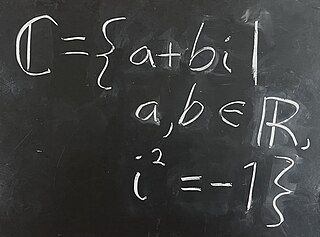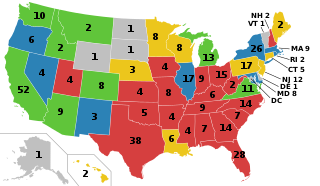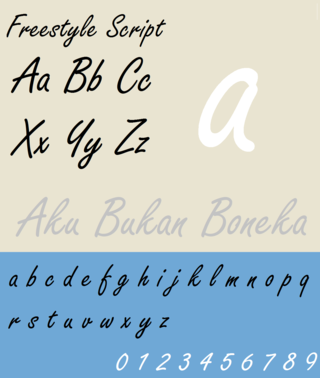
Q, or q, is the seventeenth letter of the Latin alphabet, used in the modern English alphabet, the alphabets of other western European languages and others worldwide. Its name in English is pronounced, most commonly spelled cue, but also kew, kue and que.

Typography is the art and technique of arranging type to make written language legible, readable and appealing when displayed. The arrangement of type involves selecting typefaces, point sizes, line lengths, line spacing, letter spacing, and spaces between pairs of letters. The term typography is also applied to the style, arrangement, and appearance of the letters, numbers, and symbols created by the process. Type design is a closely related craft, sometimes considered part of typography; most typographers do not design typefaces, and some type designers do not consider themselves typographers. Typography also may be used as an ornamental and decorative device, unrelated to the communication of information.

Blackboard bold is a style of writing bold symbols on a blackboard by doubling certain strokes, commonly used in mathematical lectures, and the derived style of typeface used in printed mathematical texts. The style is most commonly used to represent the number sets , (integers), , , and .

Verdana is a humanist sans-serif typeface designed by Matthew Carter for Microsoft Corporation, with hand-hinting done by Thomas Rickner, then at Monotype. Demand for such a typeface was recognized by Virginia Howlett of Microsoft's typography group and commissioned by Steve Ballmer. The name "Verdana" is derived from "verdant" (green) and "Ana".

A typeface is a design of letters, numbers and other symbols, to be used in printing or for electronic display. Most typefaces include variations in size, weight, slope, width, and so on. Each of these variations of the typeface is a font.

In writing and typography, a ligature occurs where two or more graphemes or letters are joined to form a single glyph. Examples are the characters ⟨æ⟩ and ⟨œ⟩ used in English and French, in which the letters ⟨a⟩ and ⟨e⟩ are joined for the first ligature and the letters ⟨o⟩ and ⟨e⟩ are joined for the second ligature. For stylistic and legibility reasons, ⟨f⟩ and ⟨i⟩ are often merged to create ⟨fi⟩ ; the same is true of ⟨s⟩ and ⟨t⟩ to create ⟨st⟩. The common ampersand, ⟨&⟩, developed from a ligature in which the handwritten Latin letters ⟨e⟩ and ⟨t⟩ were combined.
The Ol Chiki script, also known as Ol Chemetʼ, Ol Ciki, Ol, and sometimes as the Santhali alphabet invented by Pandit Raghunath Murmu in 1925, is the official writing system for Santhali, an Austroasiatic language recognized as an official regional language in India. It is one of the official scripts of the Indian Republic. It has 30 letters, the design of which is intended to evoke natural shapes. The script is written from left to right, and has two styles. Unicode does not maintain a distinction between these two, as is typical for print and cursive variants of a script. In both styles, the script is unicameral.
The shapes of the letters are not arbitrary, but reflect the names for the letters, which are words, usually the names of objects or actions representing conventionalized form in the pictorial shape of the characters.

Comic Sans MS is a sans-serif typeface designed by Vincent Connare and released in 1994 by Microsoft Corporation. It is a non-connecting script inspired by comic book lettering, intended for use in cartoon speech bubbles, as well as in other casual environments, such as informal documents and children's materials.
Uniscribe is the Microsoft Windows set of services for rendering Unicode-encoded text, supporting complex text layout. It is implemented in the dynamic link library USP10.DLL. Uniscribe was released with Windows 2000 and Internet Explorer 5.0. In addition, the Windows CE platform has supported Uniscribe since version 5.0.

Lettering is an umbrella term that covers the art of drawing letters, instead of simply writing them. Lettering is considered an art form, where each letter in a phrase or quote acts as an illustration. Each letter is created with attention to detail and has a unique role within a composition. Lettering is created as an image, with letters that are meant to be used in a unique configuration. Lettering words do not always translate into alphabets that can later be used in a typeface, since they are created with a specific word in mind.

Eurostile is a geometric sans-serif typeface designed by Aldo Novarese in 1962. Novarese created Eurostile for one of the best-known Italian foundries, Nebiolo, in Turin.

In metal typesetting, a font is a particular size, weight and style of a typeface. Each font is a matched set of type, with a piece for each glyph. A typeface consists of various fonts that share an overall design.

DIN 1451 is a sans-serif typeface that is widely used for traffic, administrative and technical applications.

The 4th congressional district of Illinois includes part of Cook County, and has been represented by Democrat Jesús "Chuy" García since January 2019.

Script typefaces are based on the varied and often fluid stroke created by handwriting. They are generally used for display or trade printing, rather than for extended body text in the Latin alphabet. Some Greek alphabet typefaces, especially historically, have been a closer simulation of handwriting.

The Bauhaus typeface design is based on Herbert Bayer's 1925 experimental Universal typeface and the Bauhaus aesthetic overall.

Gerrymandering is the practice of setting boundaries of electoral districts to favor specific political interests within legislative bodies, often resulting in districts with convoluted, winding boundaries rather than compact areas. The term "gerrymandering" was coined after a review of Massachusetts's redistricting maps of 1812 set by Governor Elbridge Gerry noted that one of the districts looked like a mythical salamander.
RepresentUs is a nonpartisan nonprofit organization focused on ending political corruption in the United States. Funded by donations and grants, it is run mostly by volunteers aligned in a grassroots organizing network, and it has brought in high-profile celebrities to advance its message. It advertises, produces videos, and generates publicity with speeches and demonstrations and protests.

Freestyle Script is an informal display script typeface that was designed by Colin Brignall in 1969 and Martin Wait in 1981, by Letraset. Freestyle Script is famously used for commercials in 1980s, birthday cards, decorative, logos and many others. The bold version was designed in 1986. The publishers of this font are Adobe, ITC, Monotype Imaging, Elsner+Flake, Esselte Corporation, Scangraphic Type, Linotype, Image Club, and Letraset. This font has a few versions, namely Regular, Bold, LT, Plain, LET, EF, SB, SH, SH Reg Alt, and SB Reg Alt. Freestyle Script font supports up to 78 different languages for cursive (plain) and 33 different languages for other styles. The Cyrillic version of Freestyle Script was created in 1993, consisting of the glyphs in Latin supplement. The font has been included in MyFonts since 2000.
The 1812 Massachusetts gubernatorial election was held on April 6, 1812.
















